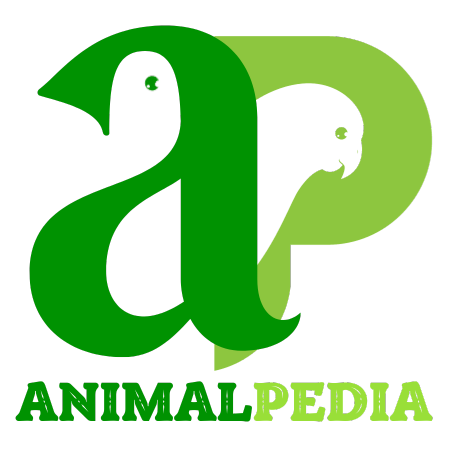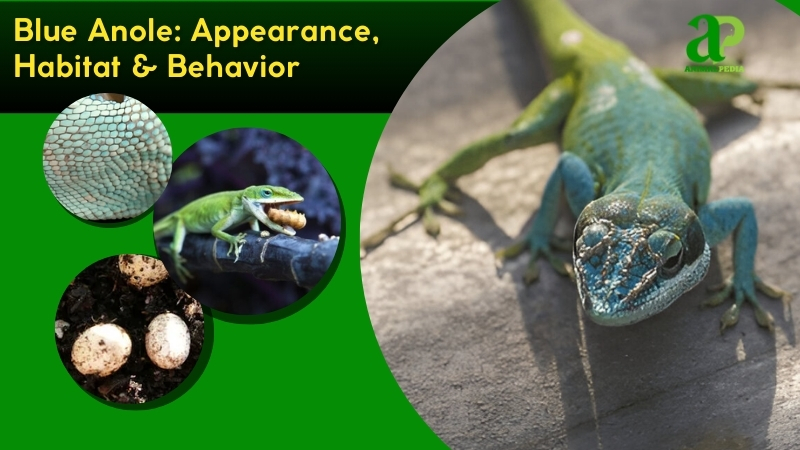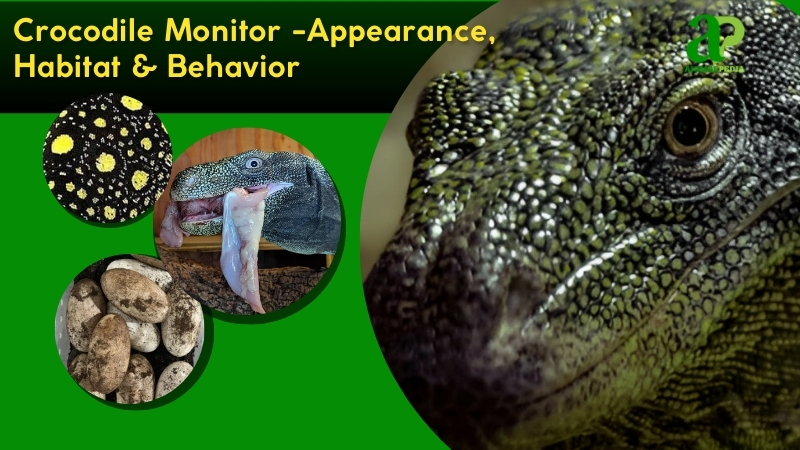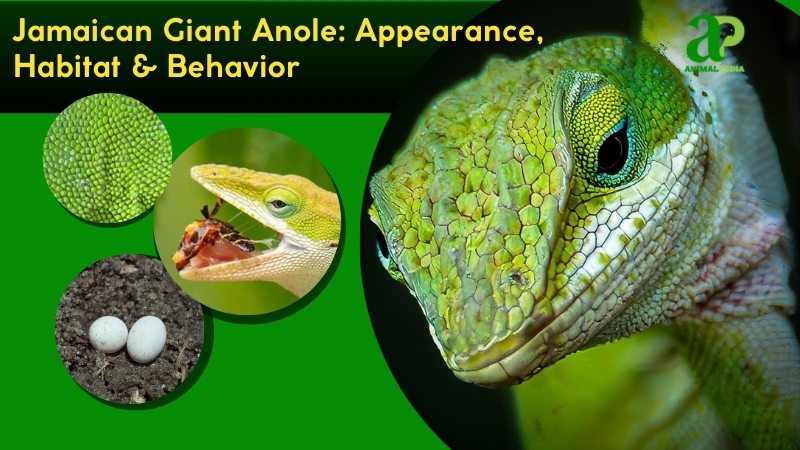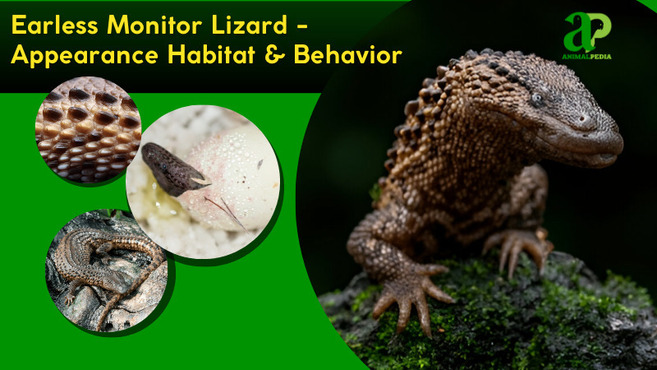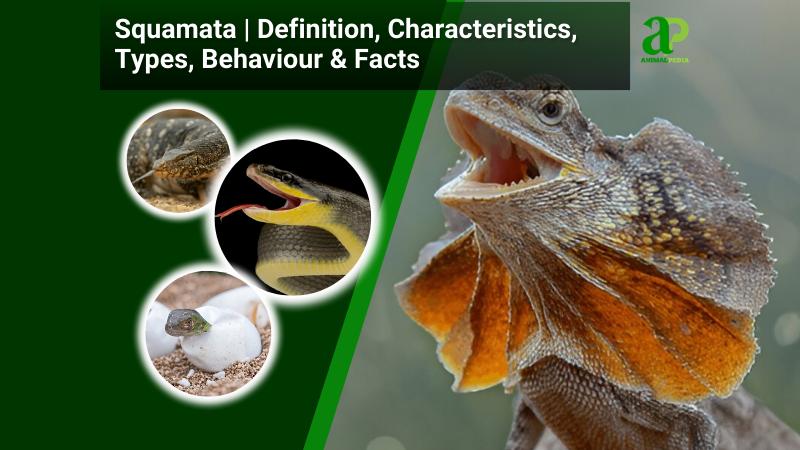The Perentie, scientifically known as Varanus giganteus, is a formidable monitor lizard found in the arid regions of Australia. Commonly referred to as the “giant monitor” or “great goanna,” this impressive reptile stands out for its sheer size, measuring up to an impressive length of 8 feet (2.5 meters), making it the largest lizard in Australia.
Distinguished by their robust, elongated bodies covered in keeled scales, Perenties display a striking pattern of light tan or yellow coloration with darker brown or black spots and bands—perfect camouflage for their harsh desert surroundings. Their triangular heads house powerful jaws and a forked tongue used with their Jacobson’s organ to expertly track prey through chemical detection.
The behavior of Perenties showcases their mastery of the Australian outback. These swift hunters can reach speeds of 25 miles per hour in short bursts, employing stealth and strategy to ambush prey ranging from small mammals and birds to reptiles and insects. When not hunting, they establish and fiercely defend individual territories, communicating primarily through body language and chemical signals.
During the mating season, female Perenties lay their eggs in burrows or under rocks, where they carefully bury them to protect from predators. After a lengthy incubation period of around 6 to 8 months, the young hatchlings emerge, displaying independent behavior from an early age. As they grow, the juveniles learn essential hunting and survival skills from their parents before reaching maturity in about 3 to 4 years.
In this detailed article, we’ll explore the intriguing world of Perentie—examining their unique physical traits, specialized adaptations to desert life, sophisticated hunting strategies, and their current conservation status. Join us as we uncover the fascinating secrets of these ancient predators that have long intrigued researchers and wildlife enthusiasts alike.
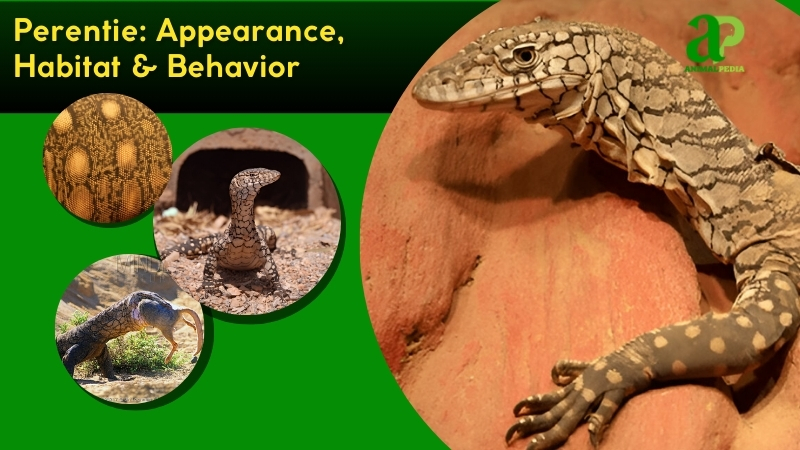
What does the Perentie look like?
The Perentie is one of the largest monitor lizards in Australia, characterized by a robust, elongated body. Its skin is rough and covered with small, keeled scales, giving it a rugged texture. The overall color is a mix of light tan or yellow, with darker brown or black spots and bands running across its body, providing camouflage in its natural desert habitat.
Its head is triangular, with large, rounded eyes equipped with a vertical slit pupil, giving it excellent vision. The tongue is forked, helping it detect scent molecules, while the muscular neck leads to a stocky, powerful body. The limbs are strong, with sharp claws that aid climbing and digging. The tail is long and tapering, aiding in balance and communication.
Compared to other monitor lizards like the perentie’s close relative, the sand monitor (Varanus gouldii), the Perentie stands out due to its larger size and more distinct pattern of darker spots and bands. The Perentie also has a significantly longer tail and thicker build than the sand monitor, which is more slender.
In terms of behavior, the Perentie is often more terrestrial, while species like the Kimberley rock monitor (Varanus glauerti) show more climbing behavior. The Perentie’s powerful limbs and claws also distinguish it from smaller species that are less capable of digging or climbing effectively.
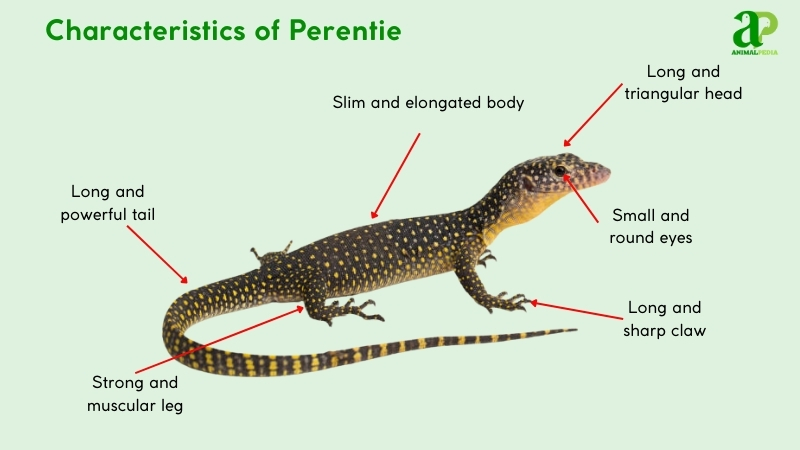
How big do Perentie get?
Perenties average 4.9–6.6 feet (1.5–2 meters) in length and 33–44 pounds (15–20 kg) in weight. The largest recorded specimen, discovered in the Australian outback, measured 8.2 feet (2.5 meters) and weighed over 44 pounds (20 kg), according to Australian Museum herpetological records.
Adults typically measure 4.9–6.6 feet (1.5–2 meters) snout-to-tail, with males exceeding females by 0.7–1 foot (0.2–0.3 meters) and 4.4–11 pounds (2–5 kg), due to males’ territorial adaptations. See the table:
| Trait | Male | Female |
| Length (ft/m) | 5.6–6.6 (1.7–2 m) | 4.9–5.9 (1.5–1.8 m) |
| Weight (lbs/kg) | 37–44 (17–20 kg) | 33–40 (15–18 kg) |
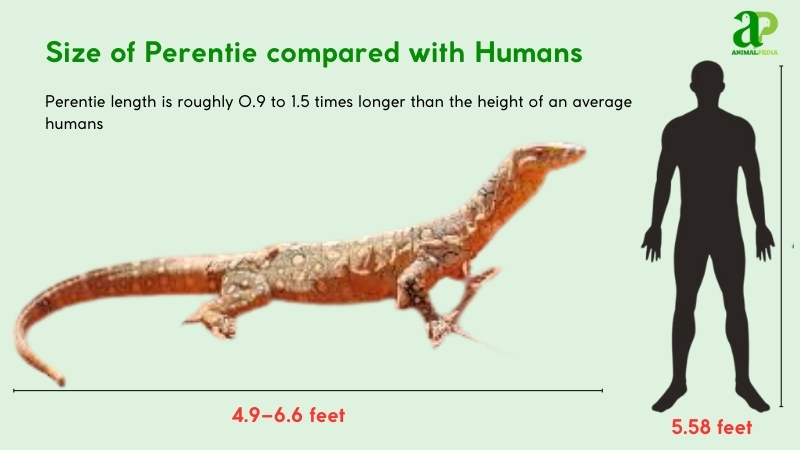
Anatomy
The Perentie is a highly specialized predator, with a range of physiological adaptations that allow it to thrive in the Australian desert. These adaptations enhance its hunting ability, survival, and resilience in an arid environment. The following systems are key to its success:
- Respiratory System: The Perentie has large, multi-chambered lungs that support its active predatory lifestyle. Air enters through the nostrils, travels down the trachea, and exchanges gases with the alveoli, providing the oxygen needed for sustained physical exertion.
- Circulatory System: Equipped with a four-chambered heart, the Perentie efficiently circulates oxygenated blood throughout its body, which supports bursts of speed and stamina during hunting and escaping threats. This heart structure is more advanced than that of most reptile classifications, allowing for better oxygen delivery to muscles.
- Digestive System: The Perentie’s expandable stomach allows it to consume large prey, while powerful digestive acids break down tough tissue. Additionally, its salivary glands produce venom that weakens prey and aids digestion.
- Excretory System: The Perentie excretes nitrogenous waste as uric acid through its cloaca, conserving water—an essential adaptation for survival in desert conditions with limited freshwater.
- Nervous System: The Perentie’s forked tongue and Jacobson’s organ help it detect chemical cues from prey and predators, enhancing its ability to navigate and hunt in its environment.
Together, these systems support the Perentie’s agility, endurance, and efficiency as a desert predator, making it one of the most formidable lizards in Australia.
Where do Perentie live?
The Perentie is primarily found in central and western Australia, with its distribution concentrated in arid regions, including the deserts of Western Australia, South Australia, and the Northern Territory. These areas offer a mix of rocky outcrops, sparse vegetation, and sandy or gravelly soil, which provide both shelter and hunting grounds for the species.
These environments are ideal for the Perentie due to their abundance of prey, such as small mammals and reptiles, and to the warm, dry climate suited to its cold-blooded nature. The Perentie thrives in environments that allow it to regulate its body temperature effectively.
Research indicates that the Perentie has been in these regions for thousands of years, with no significant migratory behavior observed. Studies of its habitat preferences show that the species is highly adapted to the desert environment and does not typically migrate in localized territories throughout its life.
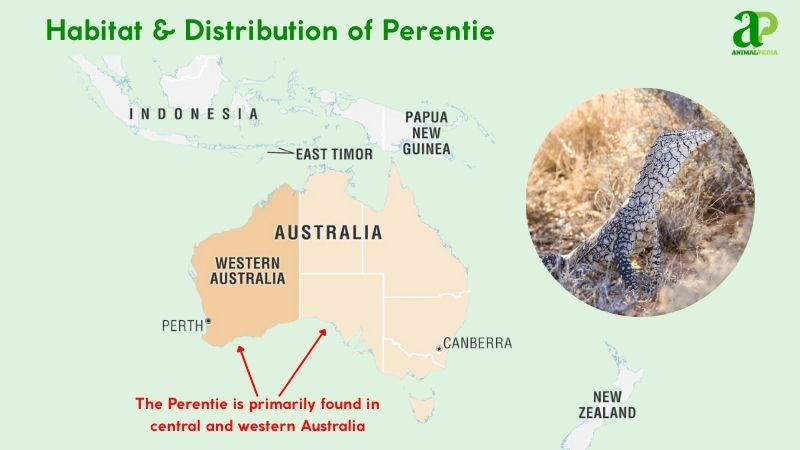
How do seasonal changes affect their behavior?
The Perentie exhibits distinct behavioral patterns linked to its desert environment, adjusting to the harsh seasonal fluctuations in temperature and resource availability.
The Perentie is primarily active during the warmer months, when it uses the desert heat to maintain its body temperature. During the cooler months, it becomes less active and seeks shelter to conserve energy. The species is known to be sedentary during colder periods, and its activity increases with rising temperatures in the warmer months.
- Warmer Months (October-March)
During this time, Perenties are highly active, hunting frequently and basking to regulate body temperature. They hunt small mammals, birds, and other reptiles, using the limited food sources that are more abundant during warmer weather. Their activity peaks in the daytime as they take advantage of the heat for optimal thermoregulation.
- Cooler Months (April-September)
In cooler months, Perenties reduce activity by 50-60%, often hidden in burrows or under rocks to avoid the extreme cold. They can go without eating for extended periods, relying on stored energy. Hunting is minimized, and the Perentie’s metabolism slows down.
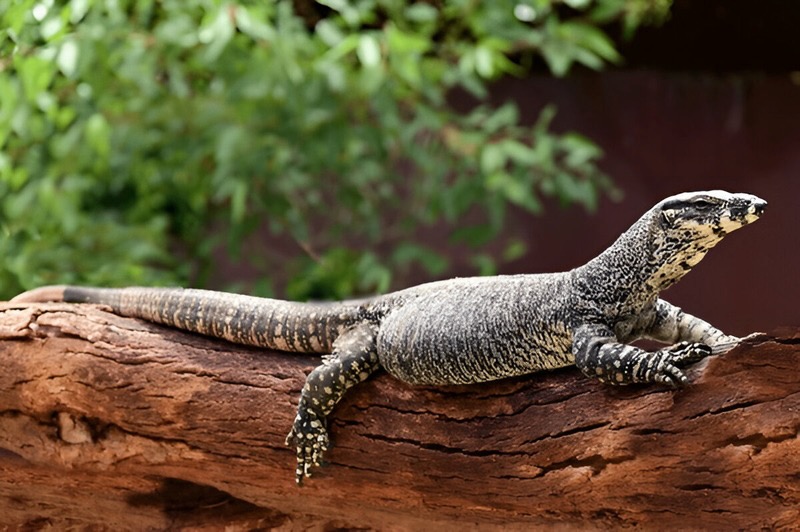
What is the behavior of Perentie?
Perentie lizards are highly adapted predators in Australia’s arid environments, exhibiting fascinating behaviors:
- Diet: Primarily carnivorous, preying on small mammals, reptiles, birds, and insects. They hunt actively, using sharp claws and strong limbs, and a venomous bite to subdue prey.
- Hunting Techniques: Rely on stealth, moving silently through their habitat, using keen eyesight and a strong sense of smell to track prey, then using speed to catch it.
- Daily Activity Patterns: Diurnal creatures, most active during the morning and late afternoon when temperatures are moderate, hunting and exploring during these times.
- Locomotion Capabilities: Agile on land, capable of reaching speeds up to 25 miles per hour; also proficient swimmers, using their muscular tail for propulsion.
- Social Structure: Solitary reptiles establish and defend territories, rarely interacting except for mating or territorial disputes.
- Communication: Communicate through body language and chemical signals, using postures and scent to mark territory and attract mates.
What do Perentie eat?
Perentie lizards are primarily carnivorous, feeding on small mammals, reptiles, birds, and insects. They are skilled hunters, using their sharp claws and strong limbs to capture prey. While the Perentie occasionally scavenges, its main feeding strategy involves actively hunting and overpowering smaller animals. Its venomous bite helps subdue prey, weakening it before consumption, though it is not typically dangerous to humans.
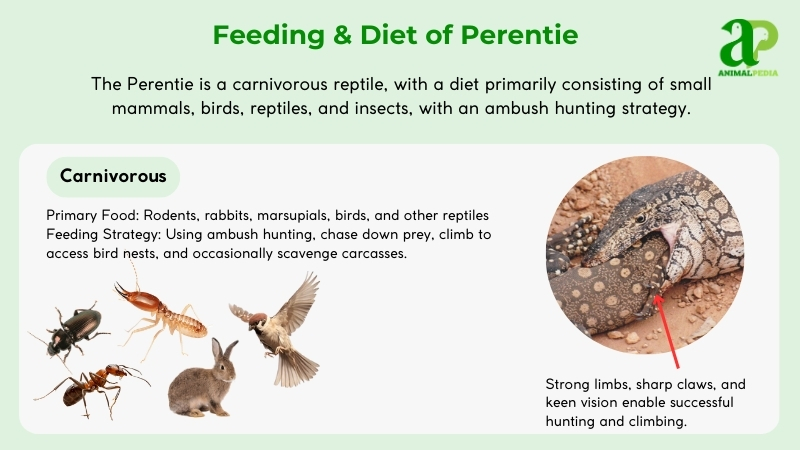
Diet by age
The Perentie’s diet evolves as it grows, adjusting to its size and hunting ability:
- Hatchlings (0-1 Year)
Young Perenties primarily eat small insects and tiny reptiles. Their diet consists of ants, grasshoppers, and small lizards, supporting rapid growth while minimizing competition with adults. - Juveniles (1-5 Years)
As juveniles grow, their diet shifts to include small mammals, birds, and larger reptiles. They begin to scavenge but still hunt actively for smaller prey. - Adults (5+ Years)
Fully grown Perenties primarily target medium-sized mammals like rabbits and bandicoots, as well as smaller reptiles. Scavenging is also common, especially in their harsh desert habitat.
Diet by gender
Both male and female Perenties share similar feeding habits. They hunt and scavenge opportunistically, with no significant dietary differences between genders.
Diet by season
Perentie lizards show some seasonal shifts in their feeding behavior. During warmer months, they are more active and their diet includes a higher proportion of insects and smaller vertebrates, as prey is abundant. In cooler months, they may rely more on scavenging and consume larger amounts of carrion, as prey becomes less active. However, their diet fairly consistent year-round, with hunting and opportunistic scavenging being key feeding strategies.
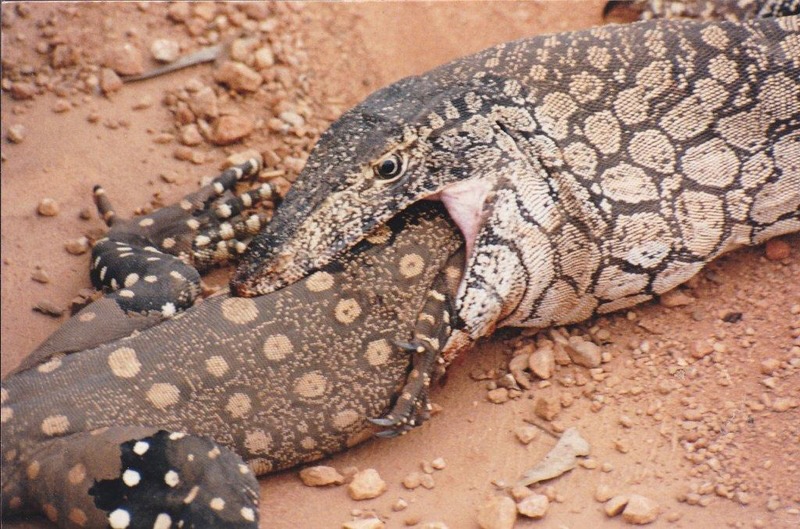
How do Perentie hunt their prey?
Perenties are skilled predators that use stealth and strategy to hunt their prey. These monitor lizards rely on their keen eyesight and strong sense of smell to locate potential meals, which range from insects to small mammals. With their powerful legs and sharp claws, Perenties sneak up on their prey with precision.
They move silently, blending into their surroundings with camouflage and patiently closing in on their target without alerting them. When the moment is right, Perenties unleash their incredible speed to surprise and catch their prey swiftly. Using their robust jaws and sharp teeth, they deliver a lethal bite to ensure a successful hunt.
Despite their size, these creatures are agile and efficient predators in their natural environment. The hunting techniques of Perenties highlight their intelligence and adaptability, establishing them as formidable hunters in the Australian wilderness. Their hunting prowess not only showcases their survival skills but also underscores their crucial role in the ecosystem.
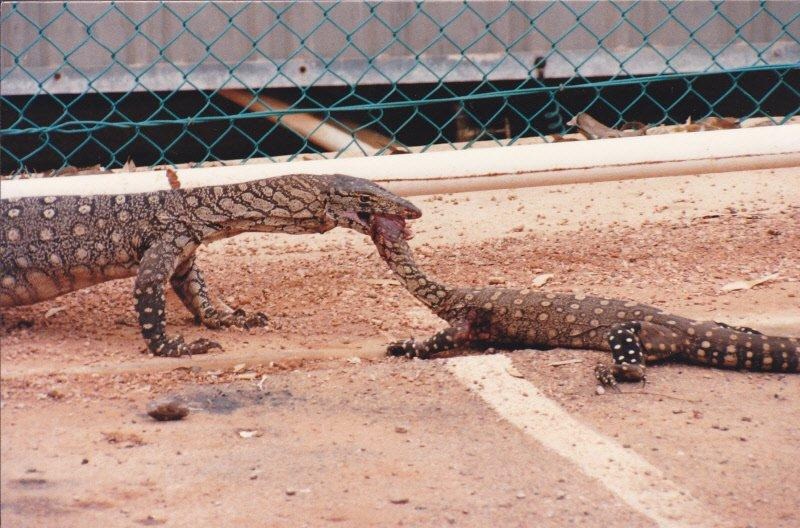
Are Perentie venomous?
When considering the Perentie, you might wonder whether it possesses venomous traits. Perenties are known for their large size and hunting skills. Unlike some venomous creatures, Perenties don’t carry venom. Instead, they rely on their powerful bite to capture their prey, inflicting substantial harm without the need for venom. Their robust jaws and sharp teeth are sufficient tools for hunting and feeding.
Despite lacking venom, Perenties are adept predators in their natural environment. They exhibit agility and speed, enabling them to catch swift prey such as birds and small mammals.
Their hunting strategies are precise and effective, establishing them as top predators in their ecosystem. This showcases their hunting abilities and adaptation to their surroundings.
When are Perentie most active during the day?
During the day, Perenties are most active as they emerge from their shelters to hunt for prey. These impressive creatures prefer the warm daylight hours to search for food, using their keen sense of smell and sharp eyesight to locate potential meals.
As the sun rises, the Perenties begin exploring their surroundings in search of prey, moving swiftly through their habitat. They’re particularly active in the morning and late afternoon when temperatures are more moderate, avoiding the intense midday heat.
If you observe during peak activity times, you may witness agile predators in action, gracefully moving across the terrain in pursuit of food. Keep an eye out during these periods to observe Perentie lizards in their natural habitat.
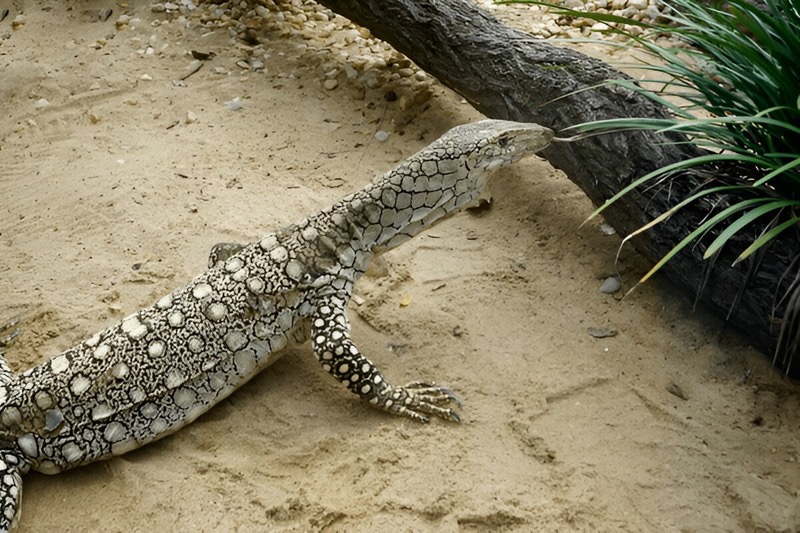
How do Perentie move on land and water?
Perenties demonstrate agility both on land and in the water. These impressive reptiles demonstrate their ability to navigate various terrains with grace and power.
On land, they can reach speeds of up to 25 miles per hour in short bursts, using their long limbs and powerful muscles for climbing and digging. This agility enables them to navigate diverse landscapes effortlessly, whether in pursuit of prey or evading threats.
In water, Perenties exhibit surprising proficiency despite not being primarily aquatic. They swim adeptly when needed, utilizing their muscular tails to propel themselves efficiently through the water. This adaptability showcases their versatility in different environments, where they can thrive and overcome challenges seamlessly.
Watching a Perentie in motion highlights the beauty and resilience of these magnificent creatures as they effortlessly shift between land and water.
Do Perentie live alone or in groups?
Perenties typically lead solitary lives, preferring independence over group living. These impressive reptiles are akin to lone wanderers in the vast Australian outback, navigating their territories on their own. Solitude grants them the freedom to hunt and explore without the constraints of group dynamics. Although they may occasionally cross paths with other perenties, they primarily stake out their own territories and defend them against intruders.
The solitary nature of perenties suits them well, as it allows them to fine-tune their hunting skills and efficiently capture prey with their sharp senses and agile movements. Living alone also means they don’t need to share food resources, ensuring their survival in the unforgiving Australian desert.
The ability to roam independently enables them to thrive as skilled predators in their harsh environment.
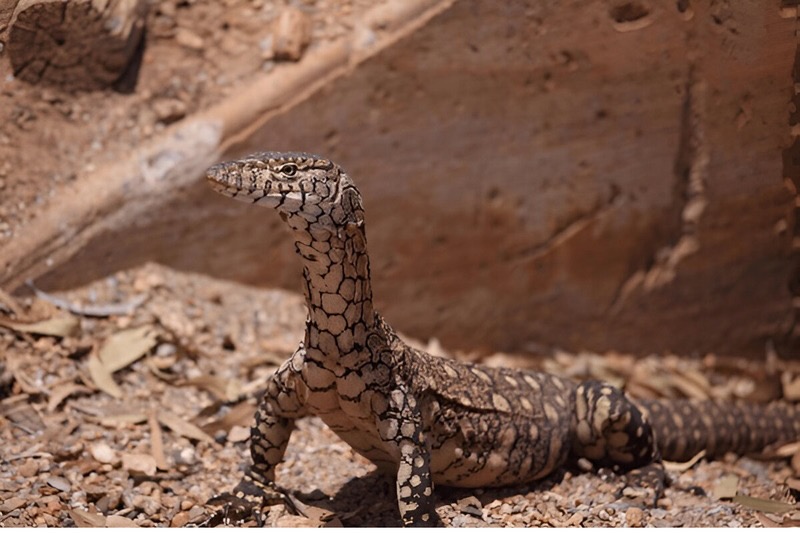
How do Perentie communicate with each other?
Perenties mainly communicate through body language and non-verbal signals. They don’t vocalize; instead, they rely on a sophisticated system of gestures and postures to interact. When they encounter each other, they may engage in head bobbing, tongue flicking, and gentle biting to establish dominance, signal submission, or convey intentions.
Besides these physical cues, Perenties use their keen sense of smell to detect pheromones and chemicals, aiding in identifying potential mates and marking territories.
Through these intricate communication methods, Perenties manage social interactions, defend territories, and establish hierarchies within their groups. Observing these behaviors in the wild offers insights into how these monitor lizards coexist in their natural habitat.
How do Perentie reproduce?
The Perentie reproduces sexually and is oviparous, laying eggs. Breeding season begins in the warmer months, typically around October to December. During this time, males become more active, engaging in combat rituals to assert dominance and attract females. These interactions often involve pushing and biting, with the dominant male eventually winning the right to mate. Mating involves the male grasping the female by the neck and mating in a semi-dominant position.
After mating, the female lays between 8 to 15 eggs, each weighing around 60-80 grams. The eggs are laid in burrows or sandy areas that provide warmth and protection. The female may initially guard the nest, but there is little parental involvement afterward. Males typically leave after mating, while females stay to protect the eggs. In rare cases, egg-laying can be interrupted by environmental factors, such as extreme temperature fluctuations or disturbances.
The incubation period for the eggs lasts around 6 to 8 months, with hatchlings emerging in late spring or early summer. Upon hatching, the young are fully independent and begin hunting immediately.
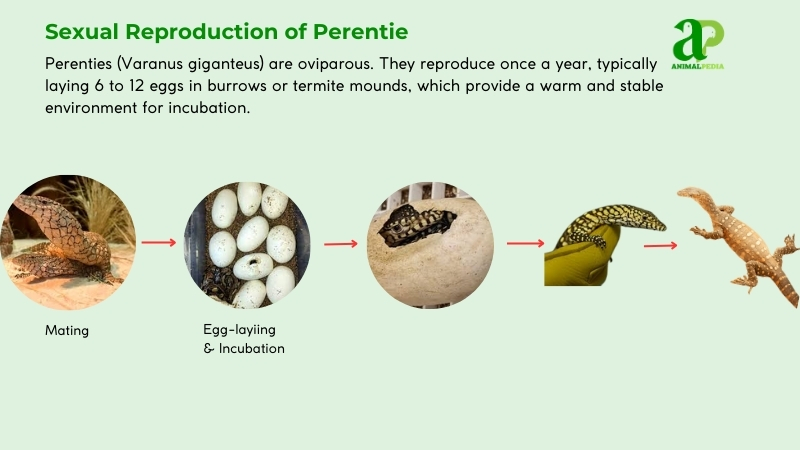
How long do Perentie live?
Perenties, the largest monitor lizards in Australia, typically live for about 10 to 15 years in the wild. These impressive creatures mature around 3-5 years of age and engage in mating rituals during the warmer months to reproduce. Female Perenties lay 6-12 eggs after mating, which hatch after approximately 250 days.
Once the eggs hatch, young Perenties are on their own, facing the challenges of predators and finding food. They continuously shed their skin to accommodate growth throughout their lives.
The long lifespan of Perenties is attributed to their adaptation to the harsh Australian environment and to their elusive behavior, which helps them avoid threats. As apex predators, Perenties play a vital role in ecosystem balance by regulating their habitats. Their presence is crucial for maintaining a healthy environment in the Australian outback.
What are the threats or predators that Perentie faces today?
The Perentie faces several threats that impact its survival in the wild. These threats primarily stem from human activity, habitat loss, and environmental changes.
- Habitat destruction: The expansion of human development, agriculture, and mining poses a significant threat to the Perentie’s natural desert habitat. As land is cleared, their access to food sources and suitable nesting sites diminishes. The impact is severe as desert ecosystems are fragmented.
- Climate change: Rising temperatures and extreme weather events disrupt the Perentie’s environment, affecting food availability and nest sites. Prolonged droughts and unpredictable rainfall patterns can lead to food scarcity, especially during critical breeding periods.
- Invasive species: Introduced predators, such as foxes, threaten Perentie populations by preying on eggs, hatchlings, and juveniles. These species outcompete native predators, disrupting the ecological balance.
- Poaching and illegal trade: While not as common, the Perentie is sometimes targeted for the illegal pet trade due to its impressive size and appearance. This illegal activity puts pressure on wild populations.
Human activities, particularly land clearing, habitat fragmentation, and the introduction of invasive species, have significantly impacted the Perentie.
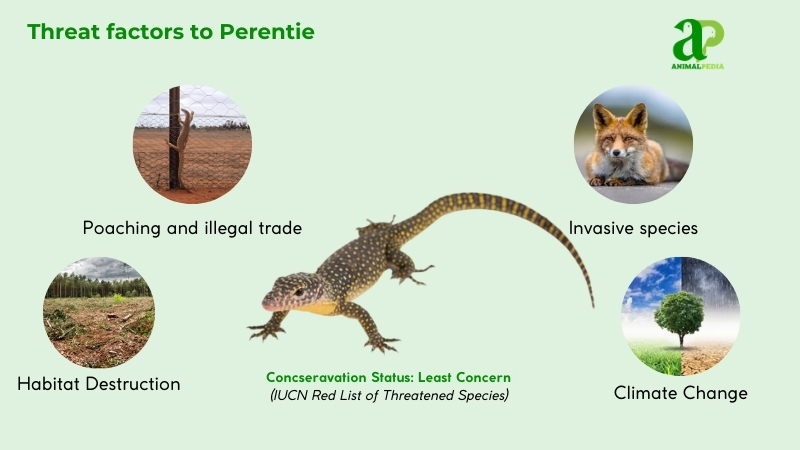
Are Perentie endangered?
The Perentie is not currently considered an endangered species. According to the IUCN Red List, the Perentie is classified as Least Concern. This classification indicates that the species is relatively stable and does not face immediate threats that could lead to a significant population decline in the near future.
Despite this, the Perentie is vulnerable to localized threats, particularly habitat loss, climate change, and predation by invasive species. However, the species’ widespread distribution across central and western Australia contributes to its overall stable population.
Specific population data for the Perentie are difficult to obtain due to its wide range and solitary, elusive nature. However, it is abundant in many of its natural habitats. According to a study by Melbourne Zoo (2019), the Perentie’s population appears stable across most of its range, though it is subject to regional fluctuations due to habitat destruction and predation pressures.
The IUCN’s classification reflects these factors, indicating that while the species faces some threats, it is not currently at risk of extinction.
What conservation efforts are underway?
Efforts are currently underway to protect Perenties from threats and predators in their habitats. Major predators of Perenties include dingoes, birds of prey, and human encroachment. Conservation organizations are actively working to safeguard Perentie populations. A key strategy is to establish protected areas where Perenties can thrive undisturbed by human activities.
Conservationists monitor populations, study behavior, and ensure habitat preservation in these zones. Educational programs are also in place to raise awareness about the significance of conserving these creatures. By sharing knowledge about Perenties and the challenges they face, more people are motivated to support conservation measures.
Through collaborative initiatives, the goal is to secure the future of these impressive reptiles and ensure their survival for future generations to enjoy.
Frequently Asked Questions
Are Perenties Dangerous to Humans?
Perennials can be dangerous to humans. Always keep a safe distance from these creatures in the wild. Their bite is powerful; it’s best to admire them from afar to avoid potential harm.
Can Perenties Be Kept as Pets?
You can’t keep perenties as pets. They are wild animals with specific habitat and diet requirements. Trying to domesticate them can be dangerous for both you and the perentie. Respecting wildlife helps protect their species.
Do Perenties Have Any Natural Predators?
Yes, Perenties do have natural predators. They face threats from animals like dingoes, eagles, and other large predators. Being vigilant and adaptive in their habitat helps them evade these dangers and survive in the wild.
Are Perenties Endangered Species?
Yes, Perenties are not classified as an endangered species. Their population is stable due to minimal threats. However, maintaining habitats and protecting them from potential dangers are crucial to secure their continued existence in the wild.
Conclusion
The Perentie is a fascinating lizard with its impressive appearance, diverse habitats, and unique behaviors. From its robust build to its keen hunting skills, this reptile is a true survivor in the wild. With its ability to regulate body temperature and navigate various environments, the Perentie exemplifies resilience and adaptability. Keep exploring the world of these incredible creatures to learn more about their intriguing lives!
